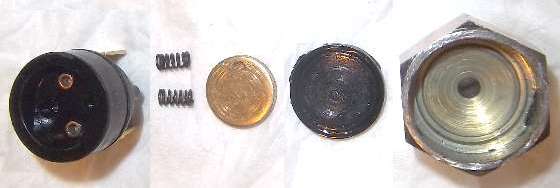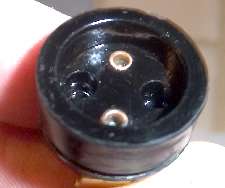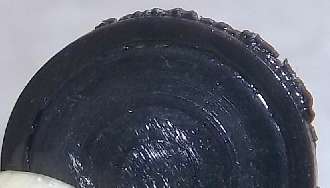The MGA With An Attitude
BRAKE LIGHT SWITCH, Construction and Failure - ET-119X
On July 02, 2013, Gordon Harrison (The Montreal Mg Car Club) wrote:
"Curious as to what was inside, these switches, I cut one apart. The switch consists of 5 pieces: a metal casing, plastic contact support, brass solid washer, two small springs, and a rubber diaphragm that is sealed around the perimeter. When the brake is applied, hydraulic pressure bends the rubber diaphragm lifting the brass washer, which in turn makes contact with the electrical connectors. The two small springs prevent the brass washer from contacting the electrical connectors when pressure is not applied".



The rubber washer is approximately 1/8th inch thick and will deform under fluid pressure. It is secured in the unit by a clamping effect when the unit is closed. It is prone to being crushed during the close up step and thus might allow brake fluid to bypass the seal. If it leaks it would leak fluid to the outside, which is not a normal failure mode. The type of brake fluid used has no affect on the electrical connection, because the fluid never touches the contacts. Pressure required to operate the switch is in the range of 30 to 50 psi (normally).
As this is not a snap action switch, the contact points close and open slowly. This allows a weak spark to jump the gap during actuation, which eventually has a burning effect on the contacts. As the contacts get dirty the contact resistance rises. The contacts then generate heat with the current. With time the resistance goes higher, and the heat will be greater. Eventually he contact resistance becomes unacceptably high with unreliable contact. Then you have to stand hard on the brake pedal before the switch will make adequate electrical contact. When the pressure required is too high, there will be no contact, and the brake lights do not work. There is no wiping action on these contacts, so the contacts are not self cleaning.
Combination of stiffness of the rubber diaphragm and strength of the springs determines how much hydraulic pressure is required to make the contacts touch. When the contacts are dirty, initial touching may not make a reliable electrical connection. Stepping harder on the brake pedal to make higher hydraulic pressure increases contact force, which may then make the electrical connection. That is, until the contacts deteriorate more. The switch must make a reliable contact with fairly low hydraulic pressure. When higher pressure is required due to deteriorated contacts, then the brake lights will not light up with normal braking pressure.
The problem with his switch is poor material for the contacts. Plating the contacts with gold, silver, or even nickle might stop the corrosion and burning. Bottom line is, this switch is unreliable due to cost cutting pennies on the quality of the internal electrical contacts.
|